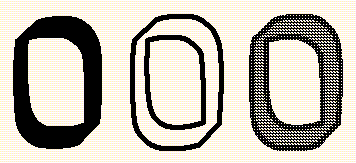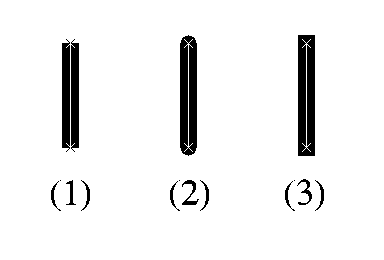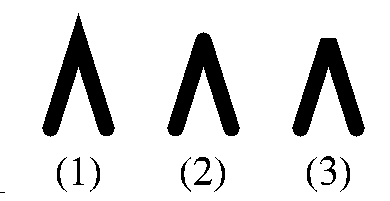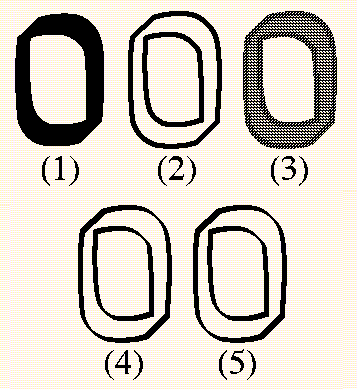Curve characters are defined in terms of mathematical curves, arcs, lines, and
movements.
On printing, these are typically painted filled
(i.e. the space between outlines becomes grey or black according to the
user specification) or
stroked (i.e. each curve or line is painted in a certain style).
The following figure shows the digit zero filled, stroked,
and stroked/filled.
A curve character painted in several paint modes |
The following ways of painting are supported in TYPO:
- Outline
- Close up and draw the (unfilled) outlines
- Even-odd fill
- Fill using the even-odd rule
- Wrap count fill
- Fill using the wrap-count rule; this is the default
- Stroke
- Stroke the outlines
- Even-odd fill/Stroke
- Fill using the even-odd rule and stroke the outlines;
this is often used for filling an outline in grey and stroking it in black
- Wrap count fill/Stroke
- Fill using the wrap count rule and stroke the
outlines; this is often used for filling an outline in grey and stroking it
in black
- Elliptic pen
- Use an elliptic pen for stroking the outlines
- Rectangular pen
- Use a rectangular pen for stroking the outlines
Character filling/stroking can be determined once for a whole font
from within the
File->Font Edit->Properties command, or for specific curve sequences
within any character with the Edit->Paint/Fill command.
TYPO provides the same
two methods of filling a character as does the PostScript language;
even-odd or wrap-count fill.
If the character consists of a single contour, such as
for the letter E, both methods yield the same
result; the contour gets filled.
If the character consists of an outer and an inner contour,
such as the character O,
the filling methods behave as follows:
For even-odd fill, the area between the two contours gets filled.
For wrap count fill, the area between the two contours gets
always filled; The inner contour gets filled only if its sense of
rotation (clockwise or counter-clockwise) is opposite to that of
the outer contour.
To exactly understand how these methods work, we imagine,
for each area surrounded by a closed curve contour,
a straight line segment beginning inside that area and ending outside the
outermost contour.
The even-odd rule determines that this area gets filled if
the line segment crosses an odd number of contours; otherwise
the area stays white. The wrap count method
determines that this area gets filled if the number of clockwise contours
crossed differs from the number of counter-clockwise contours crossed.
This rule explains why the inside of the letter O stays white
if the contours have opposite sense of rotation; any line from the inside
of the inner contour to the outside of the character will cross both
a clockwise and a counter-clockwise contour.
An in-depth discussion of
the differences between these two filling strategies appears
in the PostScript Reference Manual, page 172:
The PostScript Reference Manual, Second Edition, Addison-Wesley,
Reading, MA (1990).
For both filling methods, the user can specify the grey tone of the fill,
in percents, from 0 (white) to 100 (black), with Area grey.
As an alternative to filling, a character can be stroked.
For stroking, each curve is traced with an imaginary (circular)
pen of a given thickness.
The pen thickness can be specified with Stroke width,
and its grey tone with Contour grey
(in percents; white is zero and black is 100).
In addition, the user can determine the shape of stroke ends with the
Stroke cap menu.
This menu corresponds to the PostScript option
linecap, with the same possible choices; Butt, Round, or Square.
The effect of each of these menu choices is shown in below:
Stroke caps: (1) Butt; (2) Round; (3) Square |
If a stroke contains two adjacent curves which are not smoothly connected,
a corner is obtained. This corner can be drawn in three different ways
as determined by the menu Stroke join.
This menu corresponds to the PostScript option
linejoin, with the same possible choices;
Miter, Round, or Bevel.
The effect of each of these choices is shown in the following figure.
Stroke joins: (1) Miter; (2) Round; (3) Bevel |
Round joins are the result of applying a round pen to corners.
Miter joins are obtained by continuing both strokes along a straight
line, until the stroke outsides meet.
Bevel joins are used if a sharp corner is not desired; the peak of the
corner gets cut off.
Very small angles yield very long miter joins.
Bevel joins are automatically used instead of miter
joins if the angle is smaller than the Miter limit angle
as specified by the user. This angle corresponds to the PostScript
option miterlimit.
Unlike the PostScript option, the value of the TYPO option
Miter limit angle is expressed in degrees, for ease of use.
Filling and stroking can be combined with these two fill methods.
A typical usage is a grey area surrounded by a black stroked contour
(obtained by setting Area grey to some value
and leaving Contour grey as 100%).
Elliptic or rectangular pens can be used for stroking with
the fill methods Elliptic pen and Rectangular pen.
In both cases, the pen width, height, and angle can be specified
with Pen width, Pen height, and Pen angle.
For these two modes, the line ends and line joins
will reflect the shape of the pen.
These two methods are primarily useful for creating
METAFONT character definitions.
The following figure shows the digit zero filled, stroked, filled/stroked,
painted with an elliptic pen, and painted with a regular pen.
(1) Filled; (2) Stroked; (3) Filled/Stroked; (4) Elliptic pen; (5) Rectangular pen |
- Paint mode
- Outline, Even-odd fill, Wrap count fill, Stroke,
Even-odd fill/Stroke, Wrap count fill/Stroke,
Elliptic pen, Rectangular pen
- Area grey
- Numeric value between 0-100% (applies to all Fill paint modes)
- Contour grey
- Numeric value between 0-100% (applies to all Stroke and Pen
paint modes)
- Stroke cap
- Butt, Round, Square
(applies to all Stroke paint modes)
- Stroke join
- Miter, Round, Bevel (applies to all Stroke paint modes)
- Miter limit angle
- Numeric value between 0-180 degrees
(applies to all Stroke paint modes)
- Stroke width
- Positive numeric value (applies to all Stroke paint modes)
- Pen width
- Positive numeric value (applies to all Pen paint modes)
- Pen height
- Positive numeric value (applies to all Pen paint modes)
- Pen angle
- Numeric value between 0-360 degrees (applies to all Pen
paint modes)




